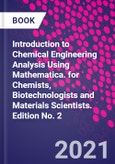Introduction to Chemical Engineering Analysis Using Mathematica, Second Edition reviews the processes and designs used to manufacture, use, and dispose of chemical products using Mathematica, one of the most powerful mathematical software tools available for symbolic, numerical, and graphical computing. Analysis and computation are explained simultaneously. The book covers the core concepts of chemical engineering, ranging from the conservation of mass and energy to chemical kinetics. The text also shows how to use the latest version of Mathematica, from the basics of writing a few lines of code through developing entire analysis programs.
This second edition has been fully revised and updated, and includes analyses of the conservation of energy, whereas the first edition focused on the conservation of mass and ordinary differential equations.
Please Note: This is an On Demand product, delivery may take up to 11 working days after payment has been received.








